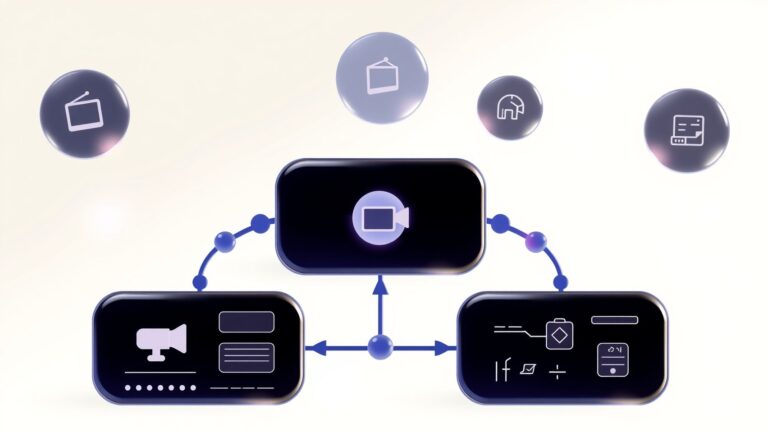How Content Teams Can Streamline AI Workflows Using Trello and Jasper for Better Results
Ever felt like herding cats would be easier than coordinating content creation across a busy team? Deadlines, edits, brainstorms, and versions flying in every direction can turn any project into a logistical headache. And just when you think things can’t get more complicated, AI tools pop up promising to make life easier—only to add another layer of confusion.
AI is reshaping content workflows, no doubt. But without clear roles or seamless integration, it can feel like you’re juggling chainsaws in the dark. That’s why combining Trello, the king of organized teamwork, with Jasper, the AI content wizard, can be a game changer. Together, they transform chaos into clarity and amplify your team’s creative power.
In this article, we’ll break down a simple, actionable workflow that empowers your team to collaborate efficiently on AI-generated content. From defining responsibilities to syncing tools, you’ll discover how to cut through the noise and reclaim your creative flow. Ready to stop spinning wheels and start producing smarter? Let’s dive in.
—
Boost your content teamwork with seamless AI collaboration—try combining Trello and Jasper today!
What Research Shows About AI and Project Management in Content Teams

As content teams increasingly integrate AI tools like Jasper and Trello into their workflows, research highlights significant gains in productivity, SEO performance, and collaborative efficiency. These findings illuminate how AI-powered automation reshapes traditional content creation processes, enabling teams to optimize efforts and deliver more impactful results. Understanding the measurable benefits and current limitations helps teams make informed decisions on adopting and fine-tuning these technologies.
By automating routine tasks, AI allows content creators to focus on higher-value activities while streamlining communication and project management through platforms like Trello. This section distills key insights from recent studies addressing the practical outcomes of combining Jasper’s AI capabilities with Trello’s organizational strengths in modern content teams.
AI-Powered Automation Reduces Manual Tasks
One of the primary advantages observed is the dramatic reduction in manual, repetitive work. Jasper’s AI handles drafting, ideation, and even optimization suggestions, significantly shortening content production cycles. Meanwhile, Trello’s task tracking and clear visual boards help teams keep all stages of the project visible and manageable, reducing time spent on status updates and coordination. Studies report up to a 30% boost in overall workflow efficiency due to these combined automations.
Jasper AI Drives SEO and Content Relevance
Jasper’s AI algorithms analyze keyword trends and competitive content to generate tailored output that aligns closely with SEO goals. Research shows that teams using Jasper experience noticeable improvements in search engine rankings and click-through rates, with some campaigns achieving increases of 15-25%. The tool’s ability to suggest contextual keywords and meta descriptions enhances relevance and user engagement, supporting better online visibility over manual content crafting alone.
Trello’s Role in Organizing Workflows and Communication
Trello serves as a central hub for content planning, assignments, and collaboration. Its flexible boards, lists, and cards ensure that roles and responsibilities are clear, deadlines are tracked, and feedback loops are streamlined. Teams report smoother internal communication and fewer missed deadlines when Trello integrates AI-generated drafts from Jasper directly into their content pipeline, fostering transparent progress monitoring and accountability.
Boosts in Productivity and User Engagement
By combining Jasper’s AI content assistance with Trello’s project management framework, many organizations realize tangible productivity gains. Research data highlights increases in the volume of content produced, coupled with qualitative improvements in engagement metrics such as click-through rates and average session duration. These dual benefits position teams to meet both quantitative and qualitative KPIs more consistently.
Data Privacy and Ethical Considerations
Research also underscores the importance of addressing data privacy and ethical use when leveraging AI. Teams must ensure compliance with regulations regarding user data handling by AI tools, especially when inputting proprietary or sensitive information into Jasper. Transparent AI usage policies and regular audits are recommended to maintain trust and adhere to ethical standards in content generation.
Existing Gaps: Creativity Support and Real-Time Analytics
Despite the clear advantages, studies point to current limitations such as Jasper’s comparatively limited capacity for true creative nuance and the absence of robust real-time analytics integration within Trello. Teams often supplement AI output with human editorial input to maintain originality and brand voice. Additionally, integrating live performance analytics into Trello boards remains a challenge, leaving a gap in immediate content impact visibility.
Setting Up Your Trello Board: Streamlined Workflows for AI Content Collaboration

When collaborating on AI-generated content, structuring your Trello board thoughtfully can transform your team’s efficiency and clarity. A well-organized board acts as the backbone of your content workflow, guiding every stage from ideation to final review with clear visibility. By aligning Trello’s features with the nuances of AI content creation, teams can tackle repetitive tasks faster, keep feedback loops tight, and assign roles that truly fit each phase of the project.
This section provides a step-by-step framework to build a Trello board optimized for AI content teams using Jasper, including list setups, automation tips, and integration tricks that help maintain momentum without sacrificing oversight.
Organizing Task Lists to Mirror Content Phases
Create lists on your Trello board that represent each phase of content development, ensuring every card has a clear lifecycle path. A typical workflow might include these lists:
- Ideas & Research: Capture AI-generated content prompts and initial research notes.
- Drafting: Cards move here once Jasper starts generating content drafts.
- Editing & Approval: Dedicated to team reviews, revisions, and final sign-offs.
- SEO & Optimization: Optimize content for search engines based on keywords and analytics.
- Scheduled & Published: Track content ready to release or already live.
Using card templates tailored to AI projects, with checklists for “Jasper prompt details,” “tone settings,” or “keywords to emphasize,” standardizes tasks and helps maintain quality during handoffs.
Leveraging Automation for Repetitive Tasks
Trello’s automation (Butler) can drastically reduce manual updates. Set rules like:
- Automatically move cards to “Drafting” when a checklist item “Content prompt finalized” is checked.
- Send reminders to assigned editors if a card remains in “Editing & Approval” for more than 48 hours.
- Label cards with “SEO Review Needed” when they enter the optimization list.
These automations keep the process flowing efficiently, so team members spend less time managing boards and more time crafting great content.
Enhancing Workflow Through Integrations
Integrations with AI tools like Sembly AI and ler can deepen your Trello workflow:
- Sembly AI: Automatically attach meeting transcripts and highlight action items for content revisions directly to Trello cards.
- ler: Use it to integrate Jasper-generated content previews instantly, allowing team members to comment without toggling platforms.
These add-ons bridge communication gaps and centralize data, turning your Trello board into a comprehensive hub.
Assigning Clear Team Roles Within Trello Cards
To avoid confusion, assign specific roles via Trello members on each card, such as:
- Content Creator: Manages Jasper prompts and initial drafts.
- Editor: Responsible for quality checks and compliance with brand voice.
- SEO Specialist: Ensures optimized keywords and metadata application.
- Project Manager: Oversees deadlines, automations, and overall flow.
This way, every team member’s responsibility is explicit, and accountability remains high throughout the content lifecycle.
Tracking Progress and Feedback Loops Efficiently
Use labels, due dates, and comment threads on cards to monitor progress and collect feedback. Regularly update cards with Jasper iteration notes and incorporate team remarks to refine content collaboratively. Employ Trello’s calendar view for deadline visibility and set up weekly board reviews to ensure all content moves steadily towards publication.
Customizing Workflows for Different Teams and Industries
The structure outlined can be adapted easily:
- Smaller teams might collapse some phases into fewer lists to simplify tracking.
- Specialized industries like technical writing or marketing may add lists for compliance checks or campaign alignment.
- Scale automation intensity depending on the volume of content and team bandwidth.
Flexibility ensures your Trello board works for your unique AI content workflow rather than forcing the team into a rigid system.
Understanding how to tailor Jasper’s functionalities for multi-user environments is essential. Teams can maintain consistent brand voice and tone using Jasper’s templates and commands, boost search engine rankings by embedding SEO keywords early in the drafting stages, and implement clear editorial workflows for review and approval. Managing user access carefully also safeguards sensitive content, enhancing overall project security.
Consistent Tone with Jasper Templates and Commands
Jasper provides customizable templates designed to align output with specific brand voices, which is crucial when multiple writers contribute to a project. Teams can create standardized Jasper commands to ensure every piece follows the desired tone and style, minimizing variation and confusion. For example, using a custom command like “Write in a conversational yet professional tone” can produce uniform content across diverse topics.
Incorporating SEO Keywords During Drafting
Rather than treating SEO as an afterthought, embedding relevant keywords while drafting with Jasper streamlines optimization. Teams can input target phrases directly into Jasper’s commands or seed content with keyword lists, enabling the AI to naturally integrate these terms. This approach not only improves search visibility but also reduces manual editing and repetitive revisions.
Collaborative Editing and Approval Workflows
Using Trello alongside Jasper enables clear tracking of content stages—from AI drafting to human editing and final approval. Assigning cards to team members for specific roles like editing or SEO review maintains accountability. Jasper-generated drafts can be linked directly to Trello cards, facilitating quick access and collective feedback. This structured flow minimizes bottlenecks and ensures a high-quality end product.
Balancing AI Suggestions with Human Creativity
While Jasper excels at generating ideas and structuring drafts, human input remains key to authenticity and nuance. Team members should treat Jasper’s outputs as a foundation that invites creative refinement. By combining AI speed with human insight, teams produce content that resonates more deeply with their audiences and preserves brand personality.
Managing User Roles to Protect Sensitive Information
Assigning differentiated access within Jasper prevents unauthorized users from viewing or modifying confidential content. Teams can designate roles—for instance, content creators, editors, and SEO specialists—with tailored permissions. This role-based access ensures that sensitive data is only handled by appropriate team members, adding a layer of security to the AI collaboration process.
Integrating Jasper Outputs into Project Management Steps
Seamless integration of Jasper-generated content into Trello’s workflow enhances organization and transparency. Teams can attach Jasper files or snippets directly to Trello cards, enabling real-time updates and comments. Automating card movements based on completion status—such as from “Drafting” to “Review”—helps track progress and align team efforts toward deadlines and goals more effectively.
Defining Roles and Responsibilities for Smooth AI Content Collaboration

Establishing clear roles within a content team that leverages tools like Trello and Jasper is crucial to maximizing efficiency and avoiding duplication of efforts. When everyone knows their specific responsibilities—especially in an AI-augmented workflow—the process flows more seamlessly, and accountability sharpens. This clarity enables teams to harness AI-generated content with confidence while maintaining high standards.
By defining roles such as the AI content strategist, editor, and project manager, teams can leverage Trello for project oversight and Jasper for content creation without crossing wires. Here’s an effective framework for structuring roles and responsibilities to optimize collaboration and maintain quality from ideation through publication.
Key Roles and Their Interaction with Trello and Jasper
The AI content strategist curates content themes, identifies opportunities for AI use, and generates high-level prompts in Jasper. They ensure AI inputs align with brand voice and objectives, minimizing irrelevant outputs. Meanwhile, the editor reviews AI-generated drafts in Jasper, refining language, fact-checking, and enforcing quality standards. This role often works closely with Trello cards indicating content status and feedback cycles.
The project manager centralizes workflow management exclusively within Trello, creating task cards, assigning owners, and tracking deadlines to maintain transparency across teams. They enable easy identification of bottlenecks by monitoring progress through Trello dashboards and facilitate smooth handoffs between AI generation and human editing.
Managing AI Inputs, Outputs, and Quality Control
The strategist is responsible for curating effective AI inputs to Jasper, continuously tweaking prompts based on output quality and team feedback. The editor handles comprehensive quality control, including ethical reviews, to ensure content adheres to guidelines and avoids AI biases or inaccuracies. Cross-functional feedback loops are encouraged through Trello comments, where team members can flag concerns and suggest improvements.
Adjusting Roles According to Team Size and Volume
For smaller teams or those with lower content volume, roles may overlap—for instance, an editor might also take on project management within Trello. Larger teams benefit from specialization, enabling more granular focus on each phase. As volume scales, increased communication via Trello ensures everyone stays aligned, preventing redundancy and streamlining AI content iterations.
Addressing AI Creativity Limits and Ethical Considerations in Teamwork

While AI tools like Jasper can accelerate content generation, teams must remain vigilant about the creative boundaries and ethical dilemmas these technologies present. AI excels at synthesizing existing information but often lacks the nuance and originality that human insight provides. Recognizing when to inject human creativity becomes essential to maintain content quality and authenticity.
Moreover, ethical considerations arise when integrating AI-produced work within team workflows, including transparency with stakeholders and safeguarding sensitive data. Establishing clear practices around these challenges ensures AI enhances the creative process without compromising trust or integrity.
Recognizing When Human Input is Necessary for Originality
AI-generated content often draws on patterns learned from existing sources, which can limit genuine innovation. Content teams should identify stages in the workflow—such as ideation, storytelling, or brand voice alignment—where human creativity is indispensable. For example, a team member might refine AI drafts by adding unique perspectives or cultural context that an algorithm cannot replicate. This blend preserves originality while leveraging AI efficiency.
Strategies to Avoid Over-Reliance on AI-Generated Content
To prevent diminishing creative diversity, teams can set usage guidelines that balance AI assistance with manual input. These may include:
- Allocating specific tasks, like data gathering or repetitive copywriting, to AI while reserving strategic messaging for humans.
- Regularly reviewing AI outputs in group sessions to critique and reshape content collaboratively.
- Encouraging team members to contribute fresh ideas outside of AI-generated templates.
Ensuring Transparency in AI Use with Stakeholders
Open communication about the role of AI in content creation builds trust both internally and externally. Teams should clarify when AI tools support content development and where human oversight occurs. Documenting these processes in project briefs or client updates promotes accountability and helps manage expectations about the final product’s origins.
Data Privacy Safeguards Within Collaborative Platforms
Integrating Trello and Jasper requires diligence to protect sensitive information. Teams must configure access controls diligently, limit sharing of confidential data within AI prompts, and review platform privacy policies regularly. Using encrypted channels and anonymizing proprietary details before input into AI systems reduces the risk of data leaks.
Building Ethics Discussions into Team Workflows
Embedding regular ethics reviews fosters a proactive culture around responsible AI use. This might include monthly team meetings to evaluate challenges like bias in AI content, potential misinformation, or unintended plagiarism. Encouraging open dialogue creates awareness and equips team members to spot and address ethical concerns promptly.
Examples of Potential Pitfalls and How to Mitigate Them
Common pitfalls include unintentional replication of copyrighted content, blind acceptance of AI-generated facts, or lack of clarity about authorship. Mitigation strategies involve implementing strict fact-checking protocols, using plagiarism detection tools, and explicitly crediting AI assistance when appropriate. By combining technical safeguards with human judgment, teams can navigate these risks effectively.
By blending data-driven insights with tailored AI interactions, teams can respond dynamically to performance trends and stakeholder feedback. Embracing these enhancements ensures that your AI-assisted content processes remain adaptive and forward-thinking as the technology landscape evolves.
Integrating Analytics Tools Alongside Trello and Jasper
Embedding analytics solutions—such as Google Analytics, HubSpot, or custom dashboards—into your Trello boards can centralize content performance data alongside task management. Using automation tools like Zapier or Integromat, teams can automatically push Jasper-generated content metrics into Trello cards, enabling real-time visibility and seamless workflow tracking.
This integration ensures that content creators and managers have an immediate grasp of how AI outputs are performing across channels, making it easier to prioritize revisions or optimize upcoming campaigns.
Tracking Content Performance Metrics Meaningfully
Measuring the right KPIs is crucial for actionable insights. Beyond page views or shares, teams should monitor engagement depth, conversion rates, and SEO impact tied directly to AI-generated content. Trello cards can house these metrics, updated dynamically, so teams assess success consistently without toggling between multiple platforms.
For example, pairing Jasper’s content suggestions with real-time A/B testing results helps refine future prompt engineering, driving more resonant messaging and improved ROI.
Using Data to Fine-Tune AI Prompts and Workflow Automations
Data-driven iteration is key to evolving effective AI prompts and automations. By analyzing performance analytics, teams can identify which Jasper outputs drive the best results and adjust prompt parameters accordingly. Trello workflows can incorporate feedback loops that trigger AI re-runs or content revisions based on these insights.
Automating routine tasks—such as content tagging or update reminders—based on analytic thresholds reduces manual overhead and sharpens focus on strategic creation.
Customizing AI Interactions for Specific Markets or Content Types
Customization extends beyond generic AI usage, tailoring Jasper’s language models to accommodate distinct audience segments or industry jargon. By cataloging content nuances within Trello and linking them to specific AI prompt templates, teams ensure consistent tone and relevance across diverse projects.
This modular approach supports quick adaptation for market shifts or emerging content formats, maintaining high-quality output at scale.
Incorporating Feedback from Diverse Stakeholders
Real-time analytics paired with transparent Trello boards simplify gathering and synthesizing input from marketing, sales, design, and legal teams. Structured comment threads and performance annotations encourage inclusive collaboration, ensuring AI-generated content aligns with cross-functional expectations.
Capturing iterative feedback as part of the workflow enhances accuracy and fosters shared accountability.
Future-Proofing Workflows as AI Tools Evolve
Building modular and scalable integrations between Trello, Jasper, and analytics platforms safeguards workflows against rapid AI advancements. Teams should architect systems that support plug-and-play additions of emerging AI features or data sources without overhauling core processes.
Regularly reviewing analytic trends and technological innovations will keep your content collaboration ahead, leveraging AI’s full potential while maintaining agility in an ever-changing digital landscape.
Embracing the synergy of Trello’s projectJasper’s AI-powered writing equips content teams to navigate the complexities of modern content creation with greater efficiency and clarity. This streamlined workflow not only clarifies roles and responsibilities but also empowers teams to produce more impactful and conscientious content, all while adapting to the evolving AI landscape.
To get started, focus on integrating just one or two of the workflow tips shared here—whether that’s defining clear reviewer roles in Trello or leveraging Jasper’s tailored content generation features. Iterate based on your team’s unique dynamics and continue refining your approach as AI tools and best practices evolve.
The key is to take action now: small, deliberate steps will build momentum, revealing what works best for your team and laying the foundation for ongoing growth. Don’t let hesitation hold you back; implementing these strategies today positions your team to harness AI’s full potential tomorrow.
Start small, stay flexible, and watch your content workflows transform—one smart decision at a time.






